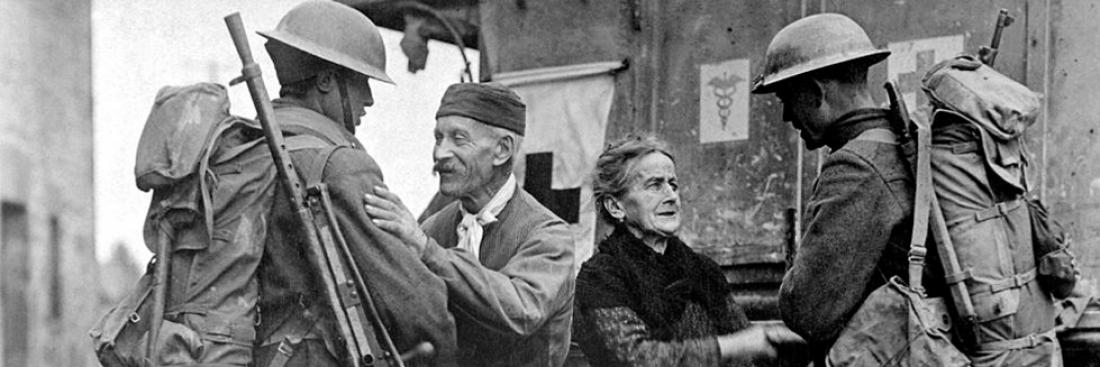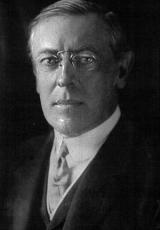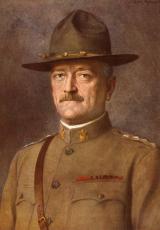Entrée en guerre des États-Unis en 1917

Corps 1
The United States entered the war in 1917 When the war broke out on 3 August 1914, the President of the United States, Woodrow Wilson, wanted to observe strict neutrality and maintain national unity in a country where one in four people was born abroad or had parents born in the two antagonistic blocs. But German provocations in early 1917 dashed American hopes of restoring peace through negotiations.
Corps 2
Economically and financially, American neutrality was theoretical: the longer the war lasted and the more total it became, the more the countries of the Entente needed the United States for their supplies of energy, raw materials, manufactured goods, food (1) and loans(2). France and Great Britain became indebted to the United States, which encouraged the Entente's victory without, however, entering the war. Wilson was re-elected in 1916 with the promise of non-intervention: his campaign slogan was "He kept us out of war". But US volunteers were already on French soil. Some had joined fighting units such as the Foreign Legion and Escadrille Lafayette, which was formed by adventurous, often wealthy pilots who aroused their compatriots' interest. By the time the squadron was incorporated into the United States Army Air Service in January 1918, 267 volunteers had signed up, 180 of who served at the front, and it had won 199 engagements. Others volunteered for health services, following the example set by the American Hospital in Neuilly-sur-Seine, which, in the conflict's earliest days, offered to treat the war wounded of all nationalities and set up an "ambulance" (army hospital) in premises loaned by the health service of the French army, transporting casualties and offering care at the cutting edge of medical technology at the time.
On 16 January 1917 Germany's State Secretary for Foreign Affairs, Arthur Zimmermann, sent a secret telegram to his ambassador in Mexico in which he suggested preparing an alliance with that country against the United States. In return, Germany promised financial aid and the restitution of Texas, New Mexico and Arizona, lost during the Mexican-American War in 1846-1848. Intercepted by the United Kingdom and published in the American press on 1 March 1917, the telegram triggered outrage in the United States. On 31 January 1917 Germany resumed "unrestricted submarine warfare", which had been suspended 18 months earlier after the sinking of the Lusitania and the United States' threats of reprisals. The Kaiser wanted to cut off supplies to Great Britain and France in order to force them to sue for peace. Now German submarines could sink American cargo ships, even if they were outside the war zone and despite the fact that they belonged to a neutral country. That decision, a vital threat to the US merchant fleet, affected the whole economy, which was booming to meet strong demand from the Entente. On 1 February 1917 Wilson broke diplomatic relations with Germany, hoping that would be enough to make Berlin abandon its plans. But nothing of the sort happened. On 13 March merchant ships received permission to arm themselves with cannons. On the 19th, the inevitable occurred: the Germans sank the Viligentia. The next day, Wilson decided on armed intervention against Germany. On 2 April he asked the Senate for a declaration of war. On 6 April 1917, at 1:18pm, Congress voted 373 for war and 50 against. President Wilson proclaimed, "America is privileged to spend her blood and her might for the principles that gave her birth..."
The United States declared war to enforce international law but lacked the means to wage it. Although the population was 103 million, the country had only a small, all-volunteer army of barely 200,000 men whose only combat experience was fighting Indians, Phillippine rebels, the Spanish in Cuba and Pancho Villa's Mexican outlaws. They seemed scarcely capable of withstanding a distant war involving a massive engagement. The army had just 285,000 rifles, 1,500 machine guns, 550 cannons, no tanks and 55 outdated planes. Only the US Navy was up to date: 14 armour-plated dreadnoughts, 250 destroyers, 36 submarines and a qualified force, including 80,000 sailors, were to serve in operations. The fleet, commanded by Admiral Sims, successfully escorted troop convoys to Europe and fought against submarines. The US declaration of war came at just the right time for the Allies: the fall of the czar and uncertainty shrouding the future of a Russia in the throes of turmoil and revolutionary agitation, the awakening of social tensions and the end of the Union sacrée (the united front the French had presented against the enemy since 1914), the bloody failure of the Nivelle offensive in the Chemin des Dames sector and mutinies on the front spelled a grim future. The announcement of US intervention came just in time to rekindle hope and the certainty that in time, "we'll win". General Pétain took command of the French army, bled white by the excesses of the strategy of offensives at any cost followed until then. He was "waiting for the Americans and tanks", he said in the spring of 1917. A French delegation, the Joffre-Viviani mission, named after the general who won the Battle of the Marne (Joffre) and the vice-president of the Council of Ministers (Viviani), was in the United States from 24 April to 15 May seeking to win over public opinion and determining exactly what the United States' military participation would be.
The Selective Service Act, which Congress passed on 18 May 1917 despite some Democrats' opposition to "another form of slavery", established conscription for all male citizens between 21 and 30 years old. The draft boosted the number of men in the army from 200,000 in February 1917 to four million by November 1918. Joffre met with a very warm welcome and signed an agreement with his American counterparts on the intervention's methods and procedures. He agreed to the creation of a US army in France as a legitimate manifestation of patriotic pride but in return obtained the sending of an expeditionary corps in June. France supplied the instructors, cannons, planes and tanks.
On 13 June 1917, 177 Americans, including General John Pershing, the expeditionary corps' commander-in-chief, and Lieutenant Patton landed in Boulogne-sur-mer as cheering crowds celebrated their arrival. "With their drab olive uniforms, wide-brimmed felt hats and many-pocketed belts, these men looking like young cowboys from the American West added an unusual, picturesque note to our war-torn landscapes," wrote the newspaper L'Illustration. Pershing seemed to be everywhere at once during the next few weeks. On 28 June he greeted the 1st DIUS arriving in Saint-Nazaire. On 4 July, Independence Day, he paid his respects to Lafayette at the marquis's gravesite at Picpus Cemetery in Paris. That is when Colonel Stanton uttered the famous line, "Lafayette, nous voilà!" ("Lafayette, we are here!"), which sent the crowd massed around the cemetery into wild cheering. On 21 August Pershing and Pétain inspected the 1st DIUS. On 6 September he was in Chaumont (Haute-Marne), his future HQ. In late October the division was assigned to a sector near Toul and Lunéville, where the troops came under fire and sustained their first casualties.
The Americans built camps, harbours and railway stations in France to bring over more than two million soldiers, tons of equipment, munitions, arms and supplies of every kind in less than 18 months. General Pershing chose Saint-Nazaire, in Loire-Atlantique, as the landing base. That is where the first ships of a convoy that had left New York with 14,750 men arrived on 26 June 1917. On 9 August a second American base opened in Bassens, in Gironde, and in September construction crews began building a veritable city in Pontanézen, near Brest, that eventually housed 70,000 American troops on their way to the front. For each man who landed, a ton of equipment also reached France. In Bassens, the Americans built an artificial harbour capable of accommodating and unloading 20 ships at a time. Soon they connected each of their harbours and camps with a rail network that reached as far as Is-sur-Tille (Côte d'Or) via Bourges and Tours. In Gièvres (Loir-et-Cher), they built a huge regulating station that included two marshalling yards, 145 hectares of storage facilities, an oil depot, a refrigeration plant, a munitions arsenal and a workshop for 200 locomotives. In November 1918 the American railway presence stood at over 30,400 employees, 14,000 cars and 1,380 locomotives.
The pace of US troop landings quickened and the number of men in the expeditionary corps on French soil soared from 78,000 doughboys in early November to nearly 150,000 by 31 December. A year later there were two million of them. In a matter of months the United States set up a war machine that intervened in a global conflict, setting the stage for its rise as a world power.
Sammies, Doughboys and GI's US soldiers who served in the Old World in 1917 were dubbed "Sammies" in reference to Uncle Sam, symbol of a paternal America, or "Doughboys", a nickname dating back to the Civil War. But where did it come from? The soldiers of that time wore tunics whose buttons looked like doughnuts ). Twenty-five years later during the Second World War US infantry men were called GI's in reference to the label on their uniforms: "Government Issue".
American Indian and Black American troops in France In 1917 a census was taken and 17,313 Indians were drafted into the US Army; 14,000 were sent to the Western front in France, not in constituted units but in specific posts, such as patrollers in the infantry or transmitters in the Signal Corps.
The Indians, who did not have US citizenship, were integrated into white units, but blacks, who were US citizens, were drafted into segregated regiments. Some 370,000 African-American soldiers served in the US Army during the First World War in the hopes that their participation would help end racial segregation and discrimination at home. But Pershing rejected any form of integration and agreed to hand those units over to French control. French arms and equipment replaced those of the doughboy. The Indians fought so heroically that several received the Croix de Guerre. Their courage under fire led the US government to grant Native Americans citizenship at last in 1919, although they were still treated like second-class citizens.
American places of remembrance in France Between the wars, the War Department created huge cemeteries and impressive memorials in France. In 1923 Congress created the American Battle Monuments Commission to maintain, guard and operate military cemeteries and monuments. Its first president was General Pershing. The United States built imposing monuments near the places where the men buried in those cemeteries fell, in particular the commemorative column in Montfaucon and the Montsec memorial in the Meuse and the Fismes column in the Marne. Many sustained damage during the Second World War and were rebuilt afterwards. Six cemeteries on French soil are the final resting places of 30,066 Americans, including 1,586 whose remains have never been identified: Aisne-Marne in Belleau and Oise-Aisne in Fère-en-Tardenois (Aisne), Meuse-Argonne in Romagne-sous-Montfaucon (Meuse), Saint-Mihiel in Thiaucourt (Meurthe-et-Moselle) and Somme in Bony (Somme). The 1,541 Americans who died in the hospital in Neuilly were buried in the cemetery in Suresnes.
Notes: (1) The United States' share of French imports soared from 10% (848 million francs) in 1913 to 30% (6.776 billion francs) in 1916. (2)France borrowed $2.3 billion from the US, whereas the Central Powers borrowed "only" $26 million.



